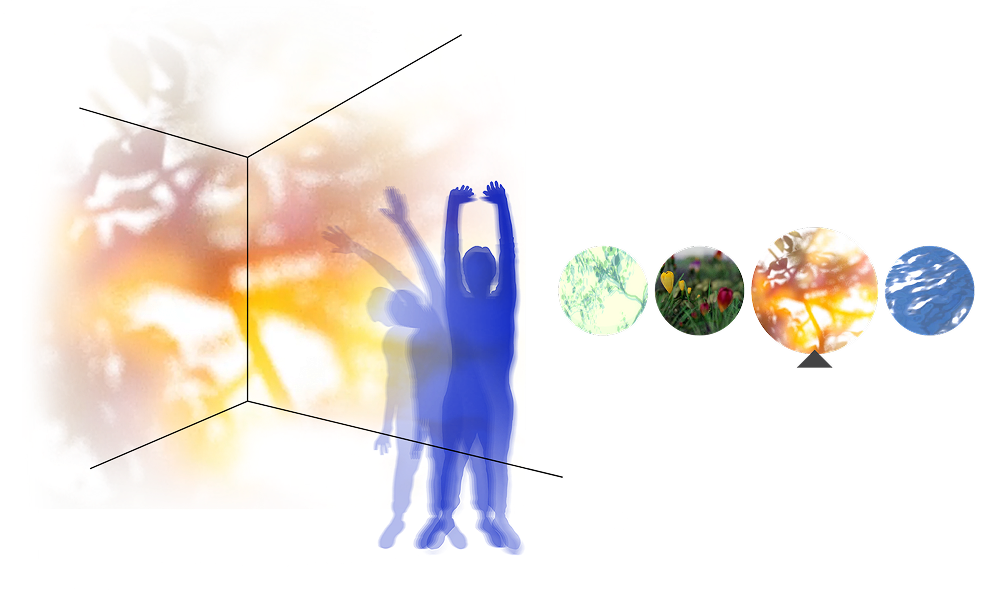Research. Breakthru Microbreaks are Science Backed.
- 2 Minutes is Just Right
- Sitting Kills
- Movement Resets the Mind
- Movement Builds Mastery
- Moving Together Builds Trust, Connection, and Collaboration
- We Use Our Mood as a Resource
- Managers and Supervisors Are Key
- Download Research One-Pager

2 mins is Just Right
Microbreaks can improve your mind and body in just 2 minutes.
Can 2-mins in motion reset your mind, mood, metabolism? The science says YES. Your metabolism decreases by 90% after 30 mins of sitting. 2-mins in motion resets it. You gain focus, energy, vigor. "Micro-breaks are efficient in preserving high levels of vigor and alleviating fatigue."7
A small habit can make a big impact: improve your physical fitness and mental wellness, reduce muscle tension, and improve your breathing, focus, motivation, and energy levels.
1-3 minute microbreaks interrupting prolonged periods of sitting were found to improve working memory, executive functions, information processing, reaction times1. Microbreaks of 30-60 seconds are beneficial for improving your musculoskeletal system and overall health2. All sedentary break doses (1 minute break every 30 or 60 minutes, or a 5 minute break every 30 or 60 minutes) yielded significant net decreases in systolic blood pressure from baseline compared with control. The largest reductions in systolic blood pressure were observed for the 1 minute break every 60 minutes3. 30-90 second microbreaks left students with a reduction in painful body regions, especially in areas prone to discomfort such as the neck, wrists, shoulders, and upper back, and a significant boost in self-efficacy. This newfound confidence was particularly evident in navigating perilous and uncomfortable situations, as well as in their ability to prevent risky scenarios4. Practitioners who take a one-minute microbreak taken every 20-40 minutes during surgical procedures experience significantly less discomfort and fatigue, with increased subjective ratings of physical performance, mental focus and without increasing their surgical duration times5. Embracing microbreaks doesn't mean sacrificing productivity. Even if the total work time is reduced due to these breaks, workers report enhanced well-being and job performance6.
- Chandrasekaran, B., Pesola, A. J., Rao, C. R., & Arumugam, A. (2021). Does breaking up prolonged sitting improve cognitive functions in sedentary adults? A mapping review and hypothesis formulation on the potential physiological mechanisms. BMC Musculoskeletal Disorders, 22(1), 1–16. https://doi.org/10.1186/s12891-021-04136-5
- Microbreaks. Stanford Environmental Health & Safety. (n.d.). https://ehs.stanford.edu/subtopic/microbreaks#:~:text=Microbreak%20Suggestions&text=Break%20up%20repetitive%20tasks%20or,60%20seconds
- Duran, A. T., Friel, C. P., Serafini, M. A., Ensari, I., Cheung, Y. K., & Diaz, K. M. (2023). Breaking Up Prolonged Sitting to Improve Cardiometabolic Risk: Dose-Response Analysis of a Randomized Crossover Trial. Medicine and science in sports and exercise, 55(5), 847–855. https://doi.org/10.1249/MSS.0000000000003109
- Grünwald, J. A., & Licka, T. F. (2023). Health Promotion for Students of Veterinary Medicine: A Preliminary Study on Active Microbreaks and Ergonomics Education. Animals (2076-2615), 13(10), 1641. https://doi.org/10.3390/ani13101641
- Coleman Wood, K. A., Lowndes, B. R., Buus, R. J., & Hallbeck, M. S. (2018). Evidence-based intraoperative microbreak activities for reducing musculoskeletal injuries in the operating room. Work, 60(4), 649–659. https://doi.org/10.3233/WOR-182772
- Give me a break!" A systematic review and meta-analysis on the efficacy of micro-breaks for increasing well-being and performance. PLoS ONE 17(8): e0272460. https://doi.org/10.1371/journal.pone.0272460
- Albulescu, P., Macsinga, I., Rusu, A., Sulea, C., Bodnaru, A., & Tulbure, B. T. (2022). “Give me a break!” A systematic review and meta-analysis on the efficacy of micro-breaks for increasing well-being and performance. PLoS ONE, 17(8), 1–27 https://doi.org/10.1371/journal.pone.0272460
Sitting Kills
Sedentary behavior negatively impacts physical fitness and mental wellness.
Many of us know that sitting for prolonged periods can hurt our health, but how bad is it really? Can standing or exercise mitigate the effects? Sitting for six to eight hours with no movement microbreaks increases the chances of developing chronic diseases1 and the chances of an early death by 18% for men and 37% for women2. This effect is not countered by standing desks or exercise before or after work1.
The health costs of sitting
The World Health Organization estimates that if we stay this sedentary, nearly 500 million people will develop heart disease, obesity, diabetes or other noncommunicable diseases this decade10. Sedentary behavior is correlated with diabetes, obesity, increased blood pressure, high blood sugar, excess body fat around the waist, unhealthy cholesterol levels, and premature mortality3. Sitting has also been proven to have correlations with a higher BMI, resting heart rate, and average heart rate6. Sedentary behavior can also lead to lifelong difficulties such as dementia and cancer. Research shows that more time spent in sedentary behaviors was significantly associated with higher incidence of all-cause dementia7 and a higher risk of cancer mortality8. Sedentary behavior is also directly linked to musculoskeletal disorders, high blood pressure, high blood sugar, high cholesterol levels, and diabetes3.
Movement microbreaks are the cure
Moving for a few minutes every 30 minutes to an hour is the solution to the health risks posed by prolonged sitting. The CDC found that physical inactivity is common with more than 60% of US women not engaging in the recommended amount of daily physical activity and more than 25% of US women not engaging in any activity at all9. Taking a 2 minute microbreak every hour is already more than 50% of the daily recommended activity and over time can improve the negative symptoms of remaining sedentary throughout the day. Moving for 5 minutes every 30 minutes reduced blood sugar spikes by 58% after meals and significantly reduced blood pressure by 4 to 5 mmHg compared with sitting all day5.
- Hamilton MT, Hamilton DG, Zderic TW: The role of low energy expenditure and sitting on obesity, metabolic syndrome, type 2 diabetes, and cardiovascular dis-ease. Diabetes https://pubmed.ncbi.nlm.nih.gov/17827399/
- Patel AV, Bernstein L, Deka A, Feigelson HS, Campbell PT, Gapstur SM, Colditz GA, Thun MJ. Leisure time spent sitting in relation to total mortality in a prospective cohort of US adults. Am J Epidemiol. 2010 Aug 15;172(4):419-29. doi: 10.1093/aje/kwq155. Epub 2010 Jul 22. https://www.ncbi.nlm.nih.gov/pmc/articles/PMC3590043/
- Park JH, Moon JH, Kim HJ, Kong MH, Oh YH. Sedentary Lifestyle: Overview of Updated Evidence of Potential Health Risks. Korean J Fam Med. 2020 Nov;41(6):365-373. doi: 10.4082/kjfm.20.0165. Epub 2020 https://www.ncbi.nlm.nih.gov/pmc/articles/PMC7700832/
- Yes, sitting too long can kill you, even if you exercise, CNN Health. 2015 Apr 30. https://www.cnn.com/2015/01/21/health/sitting-will-kill-you/index.html
- Duran, A. T., Friel, C. P., Serafini, M. A., Ensari, I., Cheung, Y. K., & Diaz, K. M. (2023). Breaking Up Prolonged Sitting to Improve Cardiometabolic Risk: Dose-Response Analysis of a Randomized Crossover Trial. Medicine and science in sports and exercise, 55(5), 847–855. https://doi.org/10.1249/MSS.0000000000003109
- Arippa, F., Nguyen, A., Pau, M., & Harris-Adamson, C. (2023). Movement Behavior and Health Outcomes among Sedentary Adults: A Cross-Sectional Study. International Journal of Environmental Research & Public Health, 20(5), 4668. https://doi.org/10.3390/ijerph20054668
- Raichlen DA, Aslan DH, Sayre MK, et al. Sedentary Behavior and Incident Dementia Among Older Adults. JAMA. 2023;330(10):934–940. doi:10.1001/jama.2023.15231
- Gilchrist, S. C., Howard, V. J., Akinyemiju, T., Judd, S. E., Cushman, M., Hooker, S. P., & Diaz, K. M. (2020). Association of Sedentary Behavior With Cancer Mortality in Middle-aged and Older US Adults. JAMA oncology, 6(8), 1210–1217. https://doi.org/10.1001/jamaoncol.2020.2045
- “Facts about women’s health.” (n.d.). CDC: National Center for Chronic Disease Prevention and Health Promotion. https://www.cdc.gov/nccdphp/sgr/women.htm#:~:text=Top%20of%20Page-,Facts,common%20among%20women%20than%20men
- Zomorodi, M., & Diaz, K. (2023, November 7). Opinion: Sitting down all day is killing us. the cure is surprisingly simple - and difficult. Los Angeles Times. https://www.latimes.com/opinion/story/2023-11-07/sitting-sedentary-screen-device-work-health-diabetes-hypertension-exercise-fitness-npr
Micro-movements Counter Pain
Sedentary behavior leads to muscle tension and musculoskeletal disorders
Research shows that taking movement microbreaks throughout the day can reduce pain, especially in the neck, wrists, shoulders, and lower and upper back1. Breaking up periods of being sedentary with movement microbreaks improves musculoskeletal pain and overall health2, leads to greater job performance, confidence, and mental focus, and reduces fatigue4.
Many of us spend the overwhelming majority of our days sitting and the pressures of working without a break negatively impacts our health. In the fast-paced world we live in, it's easy to get caught up in our daily routines, often leaving little time for physical activity. Sitting for 6 to 8 hours a day creates musculoskeletal disorders, chronic pain, and frequent trips to the doctor; while moving for just a few minutes every hour prevents these ailments, unlike an hour of exercise before or after a sedentary workday.
Movement microbreaks reduce pain
In recent studies, employees who implemented movement microbreaks into their daily routines reported experiencing fewer painful body regions and less musculoskeletal discomfort1. Engaging in non-sedentary behaviors throughout the workday, including posture changes, standing, and movement, can lead to less musculoskeletal discomfort, better cardiometabolic health outcomes, increased overall daily activity, and improved sleep quality2. The concept of microbreaks, as described in ergonomics literature, involves scheduling short rests to prevent the onset or progression of physical symptoms, such as musculoskeletal pain or discomfort3. Veterinary students, known for long hours of study and clinical work, found relief through movement-based microbreaks. Their reports showed a reduction in painful body regions, especially in areas prone to discomfort such as the neck, wrists, shoulders, and upper back1.
These findings suggest that integrating microbreaks into your daily routine can have a transformative impact on your physical health, providing relief from pain and enhancing overall well-being.
- Grünwald, J. A., & Licka, T. F. (2023). Health Promotion for Students of Veterinary Medicine: A Preliminary Study on Active Microbreaks and Ergonomics Education. Animals (2076-2615), 13(10), 1641. https://doi.org/10.3390/ani13101641
- Arippa, F., Nguyen, A., Pau, M., & Harris-Adamson, C. (2023). Movement Behavior and Health Outcomes among Sedentary Adults: A Cross-Sectional Study. International Journal of Environmental Research & Public Health, 20(5), 4668. https://doi.org/10.3390/ijerph20054668
- "Give me a break!" A systematic review and meta-analysis on the efficacy of micro-breaks for increasing well-being and performance. PLoS ONE 17(8): e0272460. https://doi.org/10.1371/journal.pone.0272460
- Coleman Wood, K. A., Lowndes, B. R., Buus, R. J., & Hallbeck, M. S. (2018). Evidence-based intraoperative microbreak activities for reducing musculoskeletal injuries in the operating room. Work, 60(4), 649–659. https://doi.org/10.3233/WOR-182772
Movement Resets the Mind
Microbreaks can reset your mind and reactivate your motivation, energy, focus, and creativity in just 2 minutes.
Microbreaks and Productivity
Many may still hold the age-old belief that not taking breaks during work means you are getting more done than those taking a lunch or getting up from their desks for a short walk. However, allowing yourself a few minutes every hour can actually boost your post-break performance and get more done than if you had just pushed through the day. Researchers at Cornell University found that microbreaks increase performance by 12.8% when done frequently and over 15% when they involve stretching and movement1. Even viewing images of nature for just 40 seconds boosts post-break performance2. Heightened stress levels can significantly impede our ability to focus and perform optimally in the workplace. At least 41% of workers report that stress diminishes their productivity, underscoring the urgent need for effective coping mechanisms and healthy breaks from work5.
Interoception and performance
Interoception, or becoming connected to and aware of our body’s movement, can transform our decision making and ability to perform difficult physical tasks. A study led by a team of economists and neuroscientists in Britain reported that financial traders who were better at detecting their heartbeats made more profitable investments and lasted longer in that notoriously volatile profession3. The benefits of microbreaks also extend to practitioners during surgery. Practitioners taking specific movement and breathing microbreaks experience significantly less discomfort and fatigue, with increased subjective ratings of physical performance, mental focus and without increasing their surgical duration times4.
- Ergonomic Management Software and Work Performance: An Evaluative Study. Cornell University Human Factors Lab Technical Report. https://ergo.human.cornell.edu/Pub/HFlabReports/EMReport201.pdf
- Conlin, A., Hu, X., & Barber, L. K. (2021). Comparing Relaxation Versus Mastery Microbreak Activity: A Within-Task Recovery Perspective. Psychological Reports, 124(1), 248–265. https://doi.org/10.1177/0033294119900347
- Paul, Annie. “How to Think Outside Your Brain”. New York Times, June 2021 https://www.nytimes.com/2021/06/11/opinion/brain-mind-cognition.html
- Coleman Wood, K. A., Lowndes, B. R., Buus, R. J., & Hallbeck, M. S. (2018). Evidence-based intraoperative microbreak activities for reducing musculoskeletal injuries in the operating room. Work, 60(4), 649–659. https://doi.org/10.3233/WOR-182772
- Flynn, J. (2022, November 2). 20 incredible productivity statistics [2023]: Average employee productivity in the U.S. Zippia. https://www.zippia.com/advice/productivity-statistics/#:~:text=Americans%20are%20simultaneously%20more%20productive,and%2053%20minutes%20a%20day.
Movement Builds Mastery
Movement microbreaks throughout the day boost feelings of accomplishment and improve cognitive performance.
Microbreak’s initial cognitive resource gains are predicted to have cascading effects on all three types of resources: cognitive resources by improving working memory and cognitive flexibility, psychological resources by prompting more neutral emotional appraisals and reduced negative emotional reactivity, and physiological resources by reducing stress reactions5.
Microbreaks and Mental Cognition
Our brains possess finite capacities for sustained attention, memory retention, and cognitive exertion. Emerging research advocates for a deliberate slowdown, a reconnection with our bodies, and a conscious effort to unload our minds, thereby optimizing cognitive output4. Microbreaks throughout the day have been linked to superior cognitive performance, enhanced mood, and a notable reduction in fatigue, when compared to both uninterrupted periods of sitting and a prolonged 30-minute exercise regiment3. Breaking up extended periods of sitting has been shown to lead to faster reaction times, improved working memory, and enhanced executive functions. This surge in energy expenditure translates to reduced odds of cognitive decline, faster information processing, and a decrease in fatigue levels2. When incorporating movement-based microbreaks into their routines, students experienced a significant boost in self-efficacy. This newfound confidence was particularly evident in navigating dangerous and uncomfortable situations, as well as in their ability to prevent risky scenarios1.
- Grünwald, J. A., & Licka, T. F. (2023). Health Promotion for Students of Veterinary Medicine: A Preliminary Study on Active Microbreaks and Ergonomics Education. Animals (2076-2615), 13(10), 1641. https://doi.org/10.3390/ani13101641
- Chandrasekaran, B., Pesola, A. J., Rao, C. R., & Arumugam, A. (2021). Does breaking up prolonged sitting improve cognitive functions in sedentary adults? A mapping review and hypothesis formulation on the potential physiological mechanisms. BMC Musculoskeletal Disorders, 22(1), 1–16. https://doi.org/10.1186/s12891-021-04136-5
- Ahmed Radwan, Luke Barnes, Renee DeResh, Christian Englund & Sara Gribanoff | (2022) Effects of active microbreaks on the physical and mental wellbeing of office workers: A systematic review, Cogent Engineering, 9:1, 2026206, https://www.tandfonline.com/doi/full/10.1080/23311916.2022.2026206
- Paul, Annie. “How to Think Outside Your Brain”. New York Times, June 2021 https://www.nytimes.com/2021/06/11/opinion/brain-mind-cognition.html
- Flynn, J. (2022, November 2). 20 incredible productivity statistics [2023]: Average employee productivity in the U.S. Zippia. https://www.zippia.com/advice/productivity-statistics/#:~:text=Americans%20are%20simultaneously%20more%20productive,and%2053%20minutes%20a%20day.
Moving together builds trust, connection, and collaboration:
Microbreaks improve group motivation, work culture, and employee engagement.
Movement microbreaks build collaboration and mutual trust among team members and enhance engagement within meetings, offering an easy and effective icebreaker to break down barriers and facilitate meaningful interactions. Beyond social dynamics, the physical component of these breaks serves a dual purpose by energizing participants, making them ready to learn and focus in meetings and training sessions.
Bodies and minds in sync
Studies conducted with adults show that moving in sync makes us better collaborators. On the most basic level, synchrony sends a tangible signal to others that we are open to collaboration, as well as capable of cooperation. Synchronized movement acts as an invitation to work together, along with an assurance that work will be productive...synchrony appears to initiate a cascade of changes in the way we view ourselves and others...rather than feeling that our individual selves have shrunk, we feel personally enlarged and empowered, as if all the resources of the group are now at our disposal6.
Engaging in synchronous group activities, whether it's simply tapping fingers in sync or engaging in physical exercise together, results in greater generosity, trust, and an increased sense of well-being. Synchronized behaviors such as walking together can even reduce prejudice3. When used as an icebreaker, movement microbreaks can set colleagues up for success by building a foundation of trust, connection, and fun.
Meetings can be a source of discomfort for some, leading to "surface acting." In an attempt to appear 'right,' employees often conceal their true emotions, leading to a lack of trust, productivity, and heightened exhaustion, burnout, and frustration2. When employees do not feel comfortable or trusting of one another they conceal great ideas to avoid shaking things up making meetings ineffective and unproductive.
Engaging in a movement microbreak before a training session or meeting can make employees happier and more willing to collaborate and pay attention, as well increase their energy levels. Virtual meetings leave employees feeling not just bored but often juggling multiple tasks or feeling pressured to do so, all while hiding behind blank cameras and muted audio1 and missing out on workplace fun with colleagues5. But research has shown that physical exercise with colleagues in the workplace elevates energy levels and mood4.
Movement microbreaks before training sessions can even positively impact our willingness and ability to learn. Exercise improves alertness, attention and motivation, while helping to build new brain cells to help you store information and boosts your ability to remember, recall and understand new vocabulary.7 Movement breaks have also been shown to increase students’ capacity to retain and learn information. They also boost students’ desire to learn, lessen boredom, and increase attentiveness and on task behavior.8
- Cerullo, M. (2022, September 30). Unnecessary meetings can cost big companies $100 million a year, report finds. CBS News. Retrieved from https://www.cbsnews.com/news/unnecessary-meetings-cost-big-companies-100-million-annually/
- Not getting much out of meetings? you may be masking your feelings too much. BPS Occupational Digest. (n.d.). https://bps-occupational-digest.blogspot.com/2013/11/not-getting-much-out-of-meetings-you.html
- Marta Zaraska, “Moving in Sync Creates Surprising Social Bonds among People,” Scientific American 323, 4, 64-69 (October 2020), doi:10.1038/scientificamerican1020-64
- Jakobsen, M.D., Sundstrup, E., Brandt, M. et al. Psychosocial benefits of workplace physical exercise: cluster randomized controlled trial. BMC Public Health 17, 798 (2017). https://doi.org/10.1186/s12889-017-4728-3
- Nancy Baym, Jonathan Larson, Ronnie Martin, “What a Year of WFH Has Done to Our Relationships at Work,” Harvard Business Review, March 22, 2021
- Paul, A. M. (2021). The extended mind: The power of thinking outside the brain. Houghton Mifflin Harcourt.
- Movement and learning. Learning Center UNC Chapel Hill. (2021, July 12). https://learningcenter.unc.edu/tips-and-tools/movement-and-learning/#:~:text=Exercise%20improves%20alertness%2C%20attention%20and,recall%20and%20understand%20new%20vocabulary.
- University of Michigan. (n.d.). Using physical movement to increase student engagement and learning. LSA. https://lsa.umich.edu/technology-services/news-events/all-news/teaching-tip-of-the-week/using-physical-movement-to-increase-student-engagement-and-learning.html#:~:text=Research%20shows%20that%20movement%20improves,can%20positively%20impact%20student%20learning.
We Use Our Mood as a Resource:
Microbreaks provide an energy boost that gets you ready to learn and work.
In our culture of overworking the challenges of maintaining mental wellness have become increasingly apparent. When employees feel good, they can endure tasks which they find tedious, such as completing repetitive work tasks8. When employees find themselves feeling mentally fatigued, they can swap and engage in different activities which can alter their mood, leaving them feeling more refreshed and vigorous8. Low energy based activities that incorporate movement and physical action are associated with a range of positive mood alterations.
Mindful movement
Beyond physical health, sedentary behavior has been identified as a contributor to negative mental outcomes, including depression, lower cognitive functioning, increased risk of dementia, and an overall lower quality of life2. Short mindfulness or relaxation interventions, such as focused breathing and body awareness, have been proven to deliver cognitive, psychological, physiological, and workplace benefits. These include improvements in visual-spatial processing, working memory, optimism, positive emotions, immune and executive functioning, job performance, job satisfaction, and work engagement1. Positive Psychology Interventions, encompassing movement and mindfulness-based microbreaks, not only significantly enhance well-being but also prove effective in treating depressive symptoms3. Additionally, happy workers, as evidenced by microbreaks, showcase increased efficiency, independence, and a positive impact on team dynamics5.
The corporate cost of sitting
Despite concerns about reduced total work time due to microbreaks, research consistently demonstrates that these breaks are beneficial for both worker well-being and job performance4. The impact of ongoing depression on productivity is stark, with workers grappling with depression being typically 35% less productive7. Employers stand to save between $2 to $4 for every $1 invested yearly in prevention and intervention programs supporting mental health6. Post-pandemic challenges have highlighted a concerning trend: a lack of movement affecting twice as many people. Given the well-established link between sedentary behavior and depression, it becomes imperative to address this issue for improved mood and reduced anxiety2.
- Gilbert, E., Foulk, T., & Bono, J. (2018). Building personal resources through interventions: An integrative review. Journal of Organizational Behavior (John Wiley & Sons, Inc.), 39(2), 214–228. https://doi.org/10.1002/job.2198
- Ahmed Radwan, Luke Barnes, Renee DeResh, Christian Englund & Sara Gribanoff | (2022) Effects of active microbreaks on the physical and mental wellbeing of office workers: A systematic review, Cogent Engineering, 9:1, 2026206, https://www.tandfonline.com/doi/full/10.1080/23311916.2022.2026206
- Sin, N. L., & Lyubomirsky, S. (2009). Enhancing well‐being and alleviating depressive symptoms with positive psychology interventions: A practice‐friendly meta‐analysis. Journal of Clinical Psychology, 65, 467–487. https://doi.org/10.1002/jclp.20593
- "Give me a break!" A systematic review and meta-analysis on the efficacy of micro-breaks for increasing well-being and performance. PLoS ONE 17(8): e0272460. https://doi.org/10.1371/journal.pone.0272460
- Kim, Sooyeol & Park, Youngah & Headrick, Lucille. (2018). Daily Micro-Breaks and Job Performance: General Work Engagement as a Cross-Level Moderator. Journal of Applied Psychology. https://psycnet.apa.org/doiLanding?doi=10.1037%2Fapl0000308
- Chisholm D., Sweeny K., Sheehan P., Rasmussen B., Smit F., Cuijpers P., & S., S. (2016). Scaling-up treatment of depression and anxiety: a global return on investment analysis. The Lancet Psychiatry. https://doi.org/10.1016/S2215-0366(16)30024-4 | https://ceoroundtable.heart.org/mentalhealth/executive-summary/key-insights/
- Leonhardt, M. (2022, July 28). Workplace mental health benefits can reduce sick days, increase productivity-and even provide savings for employers. Fortune Well.
- https://fortune.com/well/2022/06/09/workplace-mental-health-benefits-can-reduce-sick-days-increa se-productivity-provide-savings-for-employers/
- Albulescu, P., Macsinga, I., Rusu, A., Sulea, C., Bodnaru, A., & Tulbure, B. T. (2022). “Give me a break!” A systematic review and meta-analysis on the efficacy of micro-breaks for increasing well-being and performance. PLoS ONE, 17(8), 1–27 https://doi.org/10.1371/journal.pone.0272460
Managers and Supervisors are Key:
Making time for frequent breaks is hard. Research shows that we need tools, and the support of our workplaces, and each other, to take healthy microbreaks.
When perceiving a high level of supervisor support for recovery, employees believe that their supervisor wants them to detach and recover from work between a series of task episodes. This belief causes employees to feel that it is acceptable to take microbreaks at work and that engaging in microbreak activities will not lead to punishment. Therefore, employees will fully relax and enjoy their relaxation intake when engaging in micro-break activities, allowing their physiological and psychological systems to return to pre-stressor levels1.
The power of microbreaks.
Microbreaks are a powerful tool in the flow of our workday. They are shown to contribute positively to performance, engagement, mental health, productivity, motivation, and health issues. But making time for frequent breaks is hard. Many people struggle to take movement breaks from their daily routines every half an hour.The commonly cited barriers were pressure to be productive at work, feeling too busy to take a break and concerns about disrupting workplace cultural norms2. When people experience guilt or anxiety they are less likely to take a break. This behavior then contributes to the cultural norms of the particular team within which these people work, making it even harder for people to feel comfortable to take a break4. So, managers can communicate the importance of taking breaks by taking the most effective types regularly, which employees can mimic. Leading by example will help prevent the possible stigma and guilt associated with taking breaks3. The results of microbreaks come easily, so let's make it easy for employees to enjoy the benefits and create a new workplace norm of healthy break taking.
- Nie, Q., Zhang, J., Peng, J., & Chen, X. (2023). Daily micro-break activities and workplace well-being: A recovery perspective. Current Psychology, 42(12), 9972–9985. https://doi.org/10.1007/s12144-021-02300-7
- Zomorodi, M., & Diaz, K. (2023, November 7). Opinion: Sitting down all day is killing us. the cure is surprisingly simple - and difficult. Los Angeles Times. https://www.latimes.com/opinion/story/2023-11-07/sitting-sedentary-screen-device-work-health-diabetes-hypertension-exercise-fitness-npr
- Lyubykh, Z., & Gulseren, D. B. (2023, May 31). How to take better breaks at work, according to research. Harvard Business Review. https://hbr.org/2023/05/how-to-take-better-breaks-at-work-according-to-research
- Oliver, M., Rodham, K., Taylor, J., & McIver, C. (2021). Understanding the psychological and social influences on office workers taking breaks; a thematic analysis. Psychology & Health, 36(3), 351–366. https://doi.org/10.1080/08870446.2020.1764954
Request a demo to learn how teams stay sharper, healthier, and more connected with Breakthru
See how science-backed, 2-minute microbreaks can boost focus, motivation, and resilience for your organization.

Join the
45,000+
corporations, educational
communities, and non-profits
worldwide using Breakthru.















